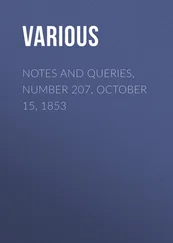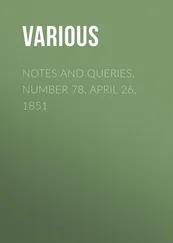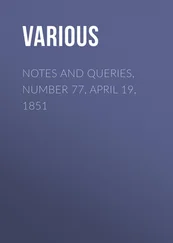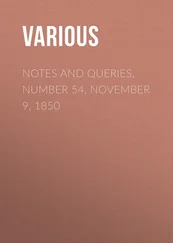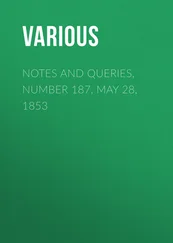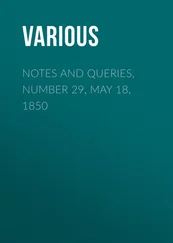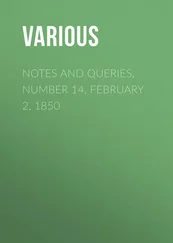Various - Notes and Queries, Number 71, March 8, 1851
Здесь есть возможность читать онлайн «Various - Notes and Queries, Number 71, March 8, 1851» — ознакомительный отрывок электронной книги совершенно бесплатно, а после прочтения отрывка купить полную версию. В некоторых случаях можно слушать аудио, скачать через торрент в формате fb2 и присутствует краткое содержание. Жанр: foreign_antique, periodic, foreign_edu, на английском языке. Описание произведения, (предисловие) а так же отзывы посетителей доступны на портале библиотеки ЛибКат.
- Название:Notes and Queries, Number 71, March 8, 1851
- Автор:
- Жанр:
- Год:неизвестен
- ISBN:нет данных
- Рейтинг книги:5 / 5. Голосов: 1
-
Избранное:Добавить в избранное
- Отзывы:
-
Ваша оценка:
- 100
- 1
- 2
- 3
- 4
- 5
Notes and Queries, Number 71, March 8, 1851: краткое содержание, описание и аннотация
Предлагаем к чтению аннотацию, описание, краткое содержание или предисловие (зависит от того, что написал сам автор книги «Notes and Queries, Number 71, March 8, 1851»). Если вы не нашли необходимую информацию о книге — напишите в комментариях, мы постараемся отыскать её.
Notes and Queries, Number 71, March 8, 1851 — читать онлайн ознакомительный отрывок
Ниже представлен текст книги, разбитый по страницам. Система сохранения места последней прочитанной страницы, позволяет с удобством читать онлайн бесплатно книгу «Notes and Queries, Number 71, March 8, 1851», без необходимости каждый раз заново искать на чём Вы остановились. Поставьте закладку, и сможете в любой момент перейти на страницу, на которой закончили чтение.
Интервал:
Закладка:
The Hippopotamus (Vol. ii., pp. 35. 277.).—I can refer your correspondent L. (Vol. ii, p. 35.) to one more example of a Greek writer using the word ἱπποπόταμος, viz., the Hieroglyphics of Horapollo Nilous, lib. i. 56. (I quote from the edition by A. T. Cory. Pickering, 1840):
"Ἄδικον δὲ καὶ ἀχάριστον, ἱπποποτάμου ὄνυχας δύο, κάτω βλέποντας, γράφουσιν."
He there mentions the idea of the animal contending against his father, &c.; and as he flourished in the beginning of the fifth century, it is probable that he is the source from which Damascius took the story.
I have in my cabinet a large brass coin of the Empress Ptacilia Severa, wife of Philip, on which is depicted the Hippopotamus, with the legend SAECVLARES. AVGG., showing it to have been exhibited at the sæcular games.
E. S. Taylor.Specimens of Foreign English. —Several ludicrous examples have of late been communicated (see Vol. ii., pp. 57. 138.), but none, perhaps, comparable with the following, which I copied about two years since at Havre, from a Polyglot advertisement of various Local Regulations, for the convenience of persons visiting that favourite watering-place. Amongst these it was stated that—
"Un arrangement peut se faire avec le pilote, pour de promenades à rames."
Of this the following most literal version was enounced,—
"One arrangement can make himself with the pilot for the walking with roars " (sic).
Albert Way.St. Clare. —In the interesting and amusing volume of Rambles beyond Railways , M. W. Wilkie Collins has attributed the church of St. Cleer in Cornwall, with its Well and ruined Oratory, to St. Clare, the heroic Virgin of Assisi; but in the elegant and useful Calendar of the Anglican Church , the same church is ascribed to St. Clair, the Martyr of Rouen. My own impression is, that the latter is correct; but I note the circumstance, that some of your readers better informed than myself, may be enabled to answer the Query, which is the right ascription? When Mr. Collins alluded to the fate of Bishop Hippo, devoured by rats, I presume he means Bishop Hatto, commemorated in the "Legends of the Rhine."
Beriah Botfield.Norton Hall, Feb. 14. 1851.
Dr. Dodd. —On the 13th February, 1775, Dr. Dodd was inducted to the vicarage of Wing, Bucks, on the presentation of the Earl of Chesterfield. On the 8th February, 1777, he was arrested for forging the Earl's bond. Dr. Dodd never resided at Wing; but, during the short period he held the living, he preached there four times. The tradition of the parish is, that on those occasions he preached from the following texts; all of them remarkable, and the second and fourth especially so with reference to the subsequent fate of the unhappy man, whose feelings they may reasonably be supposed to embody.
The texts are as follows:—
1 Corinthians xvi. 22. "If any man love not the Lord Jesus Christ, let him be Anathema Maran-atha."
Micah vii. 8. "Rejoice not against me, O mine enemy; when I fall, I shall arise; when I sit in darkness, the Lord shall be a light unto me."
Psalm cxxxix. 1, 2. "O Lord, thou hast searched me and known me. Thou knowest my down-sitting and mine up-rising, thou understandest my thought afar off."
Deuteronomy xxviii. 65, 66, 67. "And among these nations thou shalt find no ease, neither shall the sole of thy foot have rest; but the Lord shall give thee there a trembling heart, and failing of eyes, and sorrow of mind: and thy life shall hang in doubt before thee; and thou shalt fear day and night, and shalt have none assurance of thy life: In the morning thou shalt say, Would God it were even! and at even thou shalt say, Would God it were morning! for the fear of thine heart wherewith thou shalt fear, and for the sight of thine eyes which thou shalt see."
Q. D.Hats of Cardinals and Notaries Apostolic (Vol. iii. p. 169.).—An instance occurs in a MS. in this college (L. 10. p. 60.) circa temp. Hen. VIII., of the arms of "Doctor Willm. Haryngton, prothonotaire apostolik," ensigned with a black hat, having three tassels pendant on each side: these appendages, however, are somewhat different to those attached to the Cardinal's hat, the cords or strings not being fretty . I have seen somewhere a series of arms having the same insignia; but, at present, I cannot say where.
Thos Wm. King, York Herald.College of Arms, Feb. 17. 1851.
Baron Munchausen's Frozen Horn. —
"Till the Holy Ghost came to thaw their memories, that the words of Christ, like the voice in Plutarch that had become frozen, might at length become audible."—Hammond's Sermons , xvii.
These were first published in 1648.
E. H.Contracted Names of Places. —Kirton for Crediton, Devon; Wilscombe for Wiveliscombe, Somersetshire; Brighton for Brighthelmstone, Sussex; Pomfret for Pontefract, Yorkshire; Gloster for Gloucester.
J. W. H.Queries
BIBLIOGRAPHICAL QUERIES
(43.) Is there any valid reason for not dating the publication of some of Gerson's treatises at Cologne earlier than the year 1470? and if good cause cannot be shown for withholding from them so high a rank in the scale of typographic being, must we not instantly reject every effort to extenuate Marchand's obtuseness in asserting with reference to Ulric Zell, "On ne voit des éditions de ce Zell qu'en 1494?" ( Hist. de l'Imp. , p. 56.) Schelhorn's opinion as to the birthright of these tracts is sufficient to awaken an interest concerning them, for he conceived that they should be classed among the earliest works executed with cut moveable characters. ( Diat. ad Card. Quirini lib. , p. 25. Cf. Seemiller, i. 105.) So far as I can judge, an adequate measure of seniority has not been generally assigned to these Zellian specimens of printing, if it be granted "Coloniam Agrippinam post Moguntinenses primùm recepisse artem." (Meerman, ii. 106.) This writer's representation, in his ninth plate, of the type used in 1467, supplies us with ground for a complete conviction that these undated Gersonian manuals are at least as old as the Augustinus de singularitate clericorum . But why are they not older? Is there any document which has a stronger conjectural claim? Van de Velde's Catalogue , tome i. Gand, 1831, contains notices of some of them; and one volume before me has the first initial letter principally in blue and gold, the rest in red, and all elaborated with a pen. The most unevenly printed, and therefore, I suppose, the primitial gem, is the Tractatus de mendicitate spirituali , in which not only rubiform capitals, but whole words, have been inserted by a chirographer. It is, says Van de Velde, (the former possessor,) on the fly-leaf, "sans chiffres et réclames, en longues lignes de 27 lignes sur les pages entières." The full stop employed is a sort of twofold, recumbent, circumflex or caret; and the most eminent watermark in the paper is a Unicorn, bearing a much more suitable antelopian weapon than is that awkwardly horizontal horn prefixed by Dr. Dibdin to the Oryx in profile which he has depicted in plate vi. appertaining to his life of Caxton: Typographical Antiquities , vol. i.
(44.) Wherein do the ordinary Hymni et Sequentiæ differ from those according to the use of Sarum? Whose is the oldest Expositio commonly attached to both? and respecting it did Badius, in 1502, accomplish much beyond a revision and an amendment of the style? Was not Pynson, in 1497, the printer of the folio edition of the Hymns and Sequences entered in Mr. Dickinson's valuable List of English Service-Books , p. 8.; or is there inaccuracy in the succeeding line? Lastly, was the titular woodcut in Julian Notary's impression, A.D. 1504 (Dibdin, ii. 580.), derived from the decoration of the Hymnarius , and the Textus Sequentiarum cum optimo commento , set forth at Delft by Christian Snellaert, in 1496? From the first page of the latter we receive the following accession to our philological knowledge:
Читать дальшеИнтервал:
Закладка:
Похожие книги на «Notes and Queries, Number 71, March 8, 1851»
Представляем Вашему вниманию похожие книги на «Notes and Queries, Number 71, March 8, 1851» списком для выбора. Мы отобрали схожую по названию и смыслу литературу в надежде предоставить читателям больше вариантов отыскать новые, интересные, ещё непрочитанные произведения.
Обсуждение, отзывы о книге «Notes and Queries, Number 71, March 8, 1851» и просто собственные мнения читателей. Оставьте ваши комментарии, напишите, что Вы думаете о произведении, его смысле или главных героях. Укажите что конкретно понравилось, а что нет, и почему Вы так считаете.

